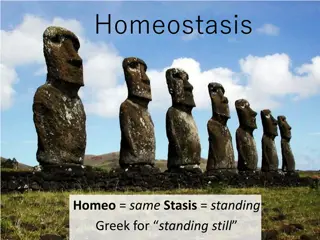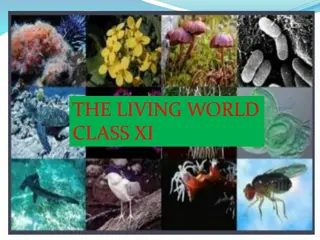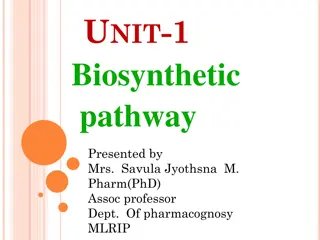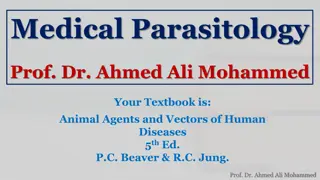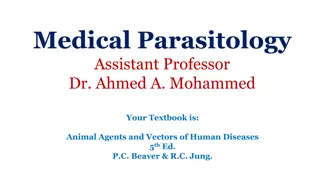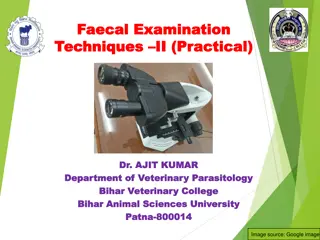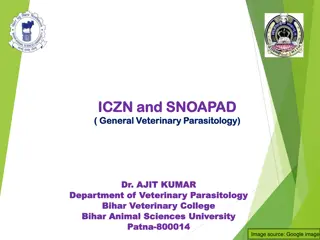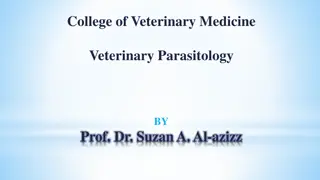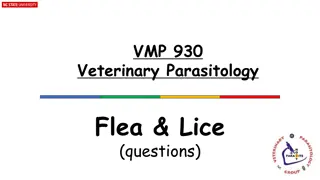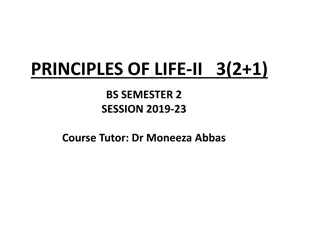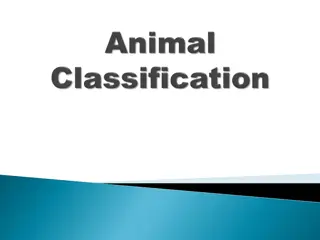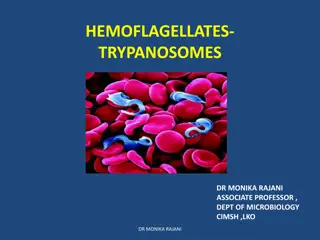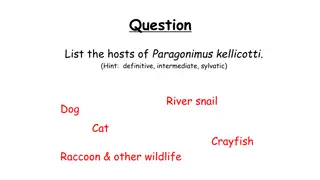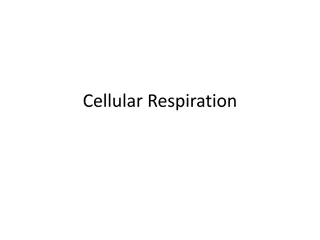Understanding Parasitology: The Study of Organisms Living on or within Hosts
Parasitology is the study of parasites, which are organisms that live on or within a host and derive nutrients from them without benefiting the host. Parasites can be classified as ectoparasites or endoparasites based on their location in or on the host. Hosts play a crucial role in the life cycle of parasites, serving as definitive hosts or intermediate hosts. Understanding the relationship between parasites and hosts is essential in medical parasitology.
Download Presentation

Please find below an Image/Link to download the presentation.
The content on the website is provided AS IS for your information and personal use only. It may not be sold, licensed, or shared on other websites without obtaining consent from the author. Download presentation by click this link. If you encounter any issues during the download, it is possible that the publisher has removed the file from their server.
E N D
Presentation Transcript
PARASITE .Parasite is a living organism which lives in or upon another organism(host) and derives nutrients directly from it without giving any benefit to the host. Protozoa and helminths (animal parasites) are studied in medical parasitology.
Parasite may be classified as : Ectoparasite- They inhabit the surface of the body of the host without penitrating into the tissues. Imp. Vectors transmitting the pathogenic microbes. Infection may be called as Infestation e.g.-fleas or ticks.
Endoparasite- They live within the body of the host (e.g Leishmania). Invasion by the endoparasite Viz Infection Endoparasite are of following types- Obligate parasite- Cannot exist without a parasitic life within the host e.g (Plasmodium spp.)
Facultative parasite- they can live a parasitic life or free living life when the opportunity arises. E.g Acanthamoeba. Accidental parasite- They infect an unusual host. e.g. Echinicoccus granulosus. Infect human accidently . Aberrant parasite or wandering parasite- They infect a host where they cannot live or develop further e.g. Toxocara in humans.
HOST Host is defined as an organism which harbour parasite and provide nourishment and shelter. Host may be of following types Definitive host The host in which the adult parasite replicate sexually ( e.g Anopheles spp.) May be humans or non humans living.
Intermediate host- in which the parasite undergoes asexual multiplication. Eg in Malaria parasite humans are the intermediate host) Int. Host are essential for the completion of life cycle for some parasite Some parasite required 2 intermediate hosts to complete their different larval stages , these are called as first and second int. Host. E.g For Fasciola hepatica amphibians snails are 1st, aqaitic plants are 2ndint host
Host can also be Reservoir host which harbours the parasite and serve as an important source of infection to other susceptible host. Eg dog is reservoir for echinococcus. Paratenic host is the host in which parasite lives but cannot develop further and not essential for life cycle e.g fresh water prawn for Angiostrongylus suitable fish for plerosercoid larva of Diphyllobothrum latum and fresh water fishes for Gnathostoma spinegerum. Function as transport or carrier host.
Amplifier host it is the host in which the parasite lives and multiplies exponentially.
HOST PARASITE RELATIONSHIP Relationship between parasite and host may be divided into following- Symbiosis- It is the close association between the host and the parasite. Both are independent upon each other that one cannot live without the help of the other. None of them suffer any harm from each other. Commensalism- It is an association in which the parasite derives benefit from the host and always causes some injury to the host. The host get no benefit in return.
Parasitism it is association in which the parasite derives benefit from the host and always causes some injury to the host . The host get no benefit in return Disease clinical manifestation of the infection , which shows the active presence ,and replication of the parasite causing damage to the host. It may be mild,severe and fulminant in same cases may cause death of the host
Carrier the person who is infected with parasite without any clinical or subclinical disease is Viz Carrier. He can transmit the parasite to others.
TRANSMISSION OF PARASITE It depends upon : Source or reservoir of infection Mode of infection source of infection- Man- is the source or reservoir for the majority of parasitic infections. The infection transmitted from one infected man to another man Viz- anthroponoses
Animals Infection which is transmitted from infected animals to humans is called as zoonoses . The infection can be transmitted to humans either directly or indirectly via vectors. vectors- vector is an agent , usullay an arthropod that transmits the infection from one infected human being to another. Vector can be biological or mechanical. An infected blood sucking insect can transmitt the parasite directly into the blood during its blood meal
contaminated soil and water- soil polluted with human excreta containing eggs of the parasite can act as an important source of infection e.g ascaris, trichura spp. Raw and undercooked meal- Raw beef containing larvae of Cysticircus bovis and pork containg Cysticercus cellulosae are some example. Other source of infection e.g fish, crab or aquatic plants.
MODES OF TRANSMISSION OROL or FECO-ORAL ROUT- Most common mode. Transmitted orally by ingestion of food ,water or vegetables contaminated with feces containing infective stages of the parasites e.g ova of Ascaris, Cyst of E histolytica
Penitration of the skin and mucous membrane- inf. Transmitted by the penitration of the larval forms of the parasite through unbroken skin filariform larva of Strongyloides stercoralis and hookworm can penetrate through the skin of an individual walking barefooted over fecally contaminated soil or by blood sucking insects vectors e.g Plasmodium.
Sexual contacts Trichomonas vaginalis. Entamoeba, giardia Entrobius also transmitted rarely by homosexuals. Bite of vectors- e.g malaria by bite of female anopheles . Vertical transmission Mother to fetus through transplacental rout e.g Toxoplasma gondii
Blood Transfusion e.g Plasmodium spp.,Toxoplasma, Leishmania, trypanosoma can be transmitted through transfusion of blood or blood products. Autoinfection- Few intestinal parasites may be transmitted to the same person by contaminated hand (external autoinfectiion) or by reverse paristalsis ( internal autoinfection) e.g Taenia solium, Entrobious vermicularis.
PATHOGENESIS OF PARASITIC DISEASE Mechanical truama Egg- Trematode eggs being large in size ,can be deposited in intestinal mucosa (Schistosoma mansoni) Lungs ( Paraoinimus), liver (Fasciola hepatica) can cause mechanical irritation. Larvae Migration of several helmenthic larvae (Hookworm, ascaris) in the lung produce traumatic damage of the pulmonary capillaries leading to pneumonitis. Adult worm adult worm of hookworm,ascaris or taenia adhere to the intestinal wall and cause mechanical trauma.
SPACE OCCUPYING LESION- certain parasite produces characteristic cystic lesion that may compress the surrounding tissue or organs, e.g Hydatid cysts, neurocysticercosis. Inflammatory reaction- Most of the parasite induce cellular proliferation and infiltration at the site of their multiplication, e.g E.histolytica provokes inflammation at large intestine- amoebic granuloma. W.broncrofti chronic blockage and chr inflammation of lymphatics and lymph vessels
Enzyme production and lytic necrosis- Obligate intracellular parasite e.g plasmodlium produces several enzymes causes digestion and necrosis of host cells. Toxins some parasite produce toxin may be responsible for pathogenesis of the disease in contrast to bacterial toxin have minimal role in pathogenesis.
Allergic manifestations -: Many metabolic and excretory products of parasite get absorbed in circulation and produce variety of allergic manifestation in sensetized person e.g ruptured hydatid cyst anaphylactic shock, occult filariasis tropical pulmonary eosiniphilia. Neoplasia Seen in some helmenth disease Schistosomiasis and strongyloidiasis. Secondary bact infection Seen in some helmenth dis. E.g Schistosomiasis .




